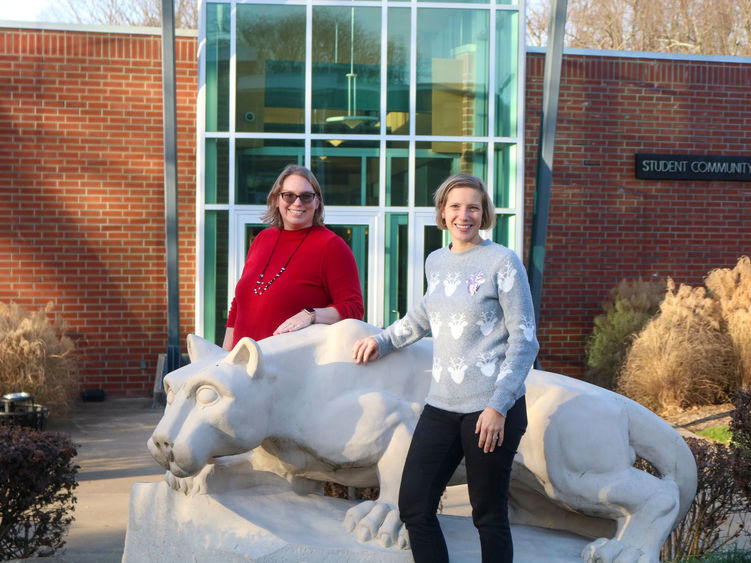
Beth Lindsey (rear) and Megan Nagel (front) received a National Science Foundation grant to examine student reasoning in chemistry and physics.
MCKEESPORT, Pa. — Penn State Greater Allegheny has received a National Science Foundation (NSF) Division of Undergraduate Education grant to understand and improve reasoning in chemistry and physics. Beth Lindsey, associate professor of physics, and Megan Nagel, interim chancellor and chief academic officer and associate professor of chemistry, will share the $2 million five-year award with faculty colleagues from University of Maine, North Dakota State University and University of North Florida.
The project, “Developing, Testing, and Disseminating Reasoning Chain Construction Tools for Use in Physics and Chemistry” seeks to develop tools and instructor guides to be used in college level physics and chemistry courses. The team's hope for this research project is to help instructors gain insights into their students’ thinking, and to recognize that some errors may be rooted in students’ reasoning abilities rather than their content understanding, allowing instructors to target their instruction more efficiently.
“We are designing tools to help students learn how to build an explanation for a scientific phenomenon. The goal is to improve student reasoning and their ability to communicate about that reasoning,” said Lindsey. “One of the most important outcomes of introductory college-level courses in physics and chemistry are the reasoning skills that students develop in those courses, more so even than the content knowledge they learn. Most students in introductory college physics or chemistry don’t go on to take upper-level courses in those areas. Instead, they put their reasoning skills to work in other areas.”
“Ultimately, we hope to improve the reasoning and critical thinking skills of students at Penn State...."—Beth Lindsey , associate professor of physics, Penn State
Lindsey and Nagel also hope to make the process of reasoning about a scientific argument more explicit to students. They want to level the playing field for students who come to college with a high desire to pursue STEM fields but are less prepared for STEM courses. “Ultimately, we hope to improve the reasoning and critical thinking skills of students at Penn State and beyond, to set them up for success in their majors and future careers,” said Lindsey.
The two faculty members have a history of research collaborations focused on an interdisciplinary understanding of energy in chemistry and physics and student metacognition, examining how well students recognize what they do and do not know. This is the first NSF grant on which they have worked together as principal investigator (Lindsey) and co-principal investigator (Nagel). Their portion of the grant is a quarter of a million dollars.
"Our faculty have a commitment to excellence in both teaching and research."—Megan Nagel , interim chancellor and chief academic officer, associate professor of chemistry, Penn State
Lindsey has been collaborating with her faculty colleagues from the other three institutions since 2002. This grant allows her to combine two successful longstanding collaborations, her work with Nagel as well as her work with the others, into one big project.
She explained that similar work for the project will be going on at all four institutions concurrently. The researchers will collaboratively develop and implement tasks at their respective institutions, while providing each other with feedback and data.
“On a small campus like Penn State Greater Allegheny, faculty have many opportunities to interact beyond our disciplinary silos. For over a decade, Dr. Lindsey and I have been collaborating and sharing ideas for how we can best leverage our scholarly expertise to support student learning,” said Nagel. “Conducting research from an interdisciplinary perspective allows for broader impact, and I am fortunate to have a research partner on the campus who shares this approach. Our faculty have a commitment to excellence in both teaching and research. This collaboration is just one example of how efforts in both areas can be combined with the goal of elevating student success.”





